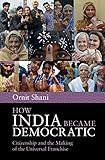How India became democratic : Citizenship and the making of the universal franchise / Ornit Shani, University of Haifa, Israel.
Publisher: Cambridge ; New York : Cambridge University Press, 2018Description: xiii, 284 pages ; 24 cmContent type:- text
- unmediated
- volume
- 9781107068032 (hardback)
- 324.60954 SHA 23
- JQ292 .S468 2018
| Item type | Current library | Call number | Status | Notes | Date due | Barcode |
|---|---|---|---|---|---|---|
 BOOKs
BOOKs
|
National Law School | 324.60954 SHA (Browse shelf(Opens below)) | Available | Donated By Vice Chancellors Office, NLSIU, Bangalore | 36065 |
Machine generated contents note;
Introduction;
1. Designing for democracy: rewriting the bureaucratic colonial imagination;
2. The pursuit of citizenship in the making of the electoral roll: registering partition refugees;
3. The roll as 'serialised epic' and the personalisation of the universal franchise;
4. Disciplining the federal structure;
5. Shaping the constitution from below and the role of the Secretariat;
6. The limits of inclusion; Conclusion:
a 17 cores and 220 yard democracy.
"How India Became Democratic explores the greatest experiment in democratic human history. It tells the untold story of the preparation of the electoral roll on the basis of universal adult franchise in the world's largest democracy. Ornit Shani offers a new view of the institutionalisation of democracy in India, and of the way democracy captured the political imagination of its diverse peoples. Turning all adult Indians into voters against the backdrop of the partition of India and Pakistan, and in anticipation of the drawing up of a constitution, was a staggering task. Indians became voters before they were citizens - by the time the constitution came into force in 1950, the abstract notion of universal franchise and electoral democracy were already grounded. Drawing on rich archival materials, Shani shows how the Indian people were a driving force in the making of democratic citizenship as they struggled for their voting rights"-- Provided by publisher.

There are no comments on this title.